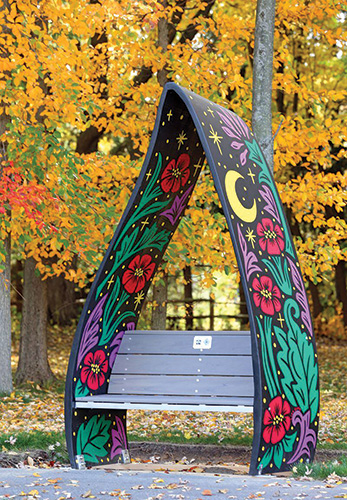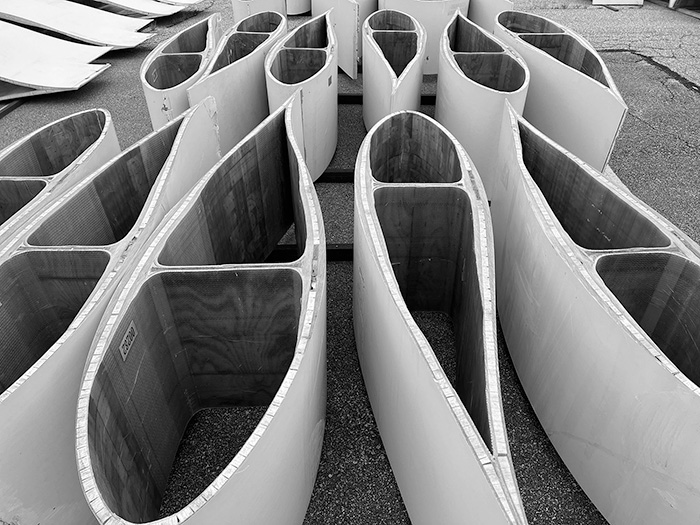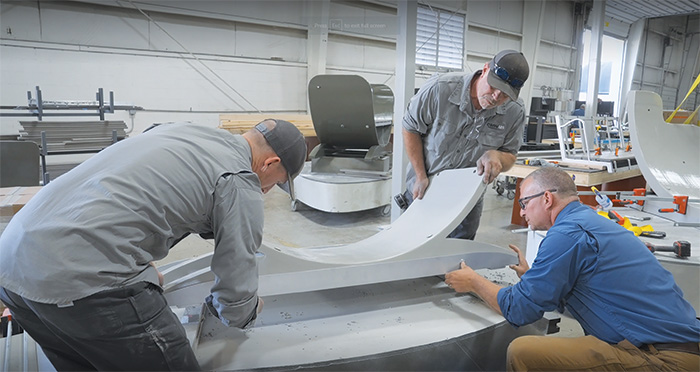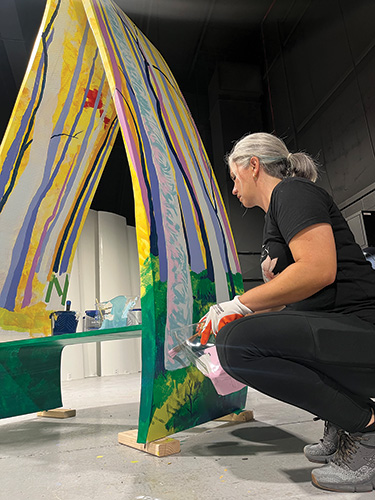With thousands of wind turbine blades being retired each year, Canvus has developed an innovative solution by upcycling them into furniture for parks, communities, and schools. Brian Donahue, Managing Partner, talks about the start of the company, how they created the reuse process, and their ultimate goals.
Talk about Canvus’ history. How did it get started?: A number of us that are involved in Canvus previously worked for another company that brokered surplus and distressed energy assets. One of their main lines of business was handling turbines when they were taken down at windfarms. All of the metal components and fluids need to be recycled, including the fiberglass blades, which were 150 to 170 feet long. While recycling metal and fluids has been around for a long time, there was really nowhere to go with the fiberglass. The only options were to landfill, which was not a good idea, especially since you are talking about thousands of fiberglass blades per year that are not breaking down anytime soon. Another option was to destroy the blades—grinding them up to use as aggregate in asphalt and concrete and to use for fuel in cement kilns. So, we wanted to figure out a better way to handle this type of waste by looking at the blades differently.
One of our founders, came up with the idea to cut the blades into smaller cross-sections, called fillets, and turn them into furniture—and that is how Canvus was started. That founder had a college roommate who graduated with an architecture degree. We brought him in, and he’s really the one that put together the designs, the CAD drawings, the engineering, the creation of the products, so we could get into production and produce these products at scale. We had a lot of trial and error. In order to understand cutting and repair, we created a lot of internal products such as workshop tables and carts from the blades as well.

This was about three years ago. Along the way had to learn a lot because no one in the U.S. was dealing with this situation at any sort of scale, so we had to figure out what size manufacturing facility, the materials, and tools that were needed. That is where we spent the last few years. We started full production last year, started shipping in August 2023, and haven’t slowed down since.
What manufacturers or service providers/companies do you work with to get the material?: There are two options for us to get blades. One is the windfarm owners. When they have blades that need to come down, they can reach out directly to Canvus. We are in communication with many of them because they are aware of our solution. In turn, some of them actually purchase our furniture and donate them to their communities. It’s a natural fit. Another source is the turbine manufacturers. Sometimes when blades come down, they are responsible for the process. We have relationships established with them and they know Canvus very well. We do not have to worry about getting raw material in terms of the blades. The blade is the foundation of our product. It had a life creating energy and now it’s time for it to have a second act. We have also combined it with other materials that are in their second life as well. We use benches that are created out of composite lumber, shrink wrapped bags, or ground up siding PVC based composite. We also use rubber tires from retired trucks and cars that have been turned into crumb rubber, and shoe waste from shoe manufacturers when they are grinding up the excess rubber. Finally, we use plastic board that combines mixed polymers, which are really hard to recycle because you can’t pull them apart and they melt at different temperatures, plus material from the carpet industry and municipal waste which can’t be mechanically separated. All of those products combined with the blade become part of the bench. Our craftsmen make all of our benches at our manufacturing facility in Avon, OH.

Explain the process from getting the material to when it becomes a new product: Once the blade is on the ground, we either pick it up and bring it back to Avon, or we contract a company to go to the windfarms and cut the blades into 40 to 50 foot sections to ship them to us. The logistics are incredible. The blade is cut into three or four cross-sections, depending on the size. Since our goal is to upcycle as much of the blade as we can, we make sure that the cutting starts as close to where the blade connects to the turbine; then, the blade is brought back to our headquarters. If any part of the blade is damaged, we grind that to be used in other aggregate or cement kilns. The material that comes back to Avon is typically 24-foot or 50-foot-long pieces. From there, we cut them into cross sections depending on the product we are making. We use a special saw that we brought over from Italy that is designed to cut marble and granite countertops, so it goes through the fiberglass quite nicely. Once the blades come into our facility, our craftsmen start fiberglass restoration. When these blades came down, they might have been dragged along the ground or were hit by hail while they were up in the air, so the craftsmen will smooth out the surface and seal the edges—anything they can do to make it more aesthetically pleasing and fixing any damage with body fillers that they use for boat repair. The blade is hollow, so we use aluminum joints and put in a composite subfloor that the bench will sit on. Once that is in, it goes through the paint booth. We paint each piece with a two-part epoxy paint, so it will stand the test of time. If someone in the community decides to graffiti the furniture, it will wash off easily with a power washer. Once they come out of the paint booth, they go over to final assembly and either depending on the order, we will make the bench seat out of recycled rubber, or we use the composite lumber and aluminum frames to create the bench and insert that into the product. As soon as the rubber is poured and cured, it goes to its shipping lane, ready to go out to a community.

Is there a type of bench style that is most popular? Who do you usually sell to? Our focus on creating benches to begin with was twofold. We wanted to be able to solve the problem at scale. There are 3,000 to 8,000 blades coming down per year and we wanted to go big—that was part of the drive to do the benches. They are also created for public spaces. Communities have tons of area for products like this. There are 19,500 cities in America and about 140,000 school systems between K-12 and universities; and about 7,000 local and state park systems. Not only did we want to make products to scale, but also for a massive marketplace. There are more than 200,000 different entities that we can call and introduce our product, and the more demand that we have, the more we can upcycle the blades. Our business development team reaches out to potential clients all over the country, including cities, townships, counties, universities, national state parks, local parks, etc. Our team is always trying to introduce them to our furniture. We have been very successful with communities that are allocating bonds and buying directly.
We design products that can be made from any model of blade, so there’s probably anywhere from 75 to 100 different models that are in the air in the U.S. and our products will be different sizes depending on the blade, but we can still recycle 100 percent of the blade and if it gets turned into furniture that’s great for upcycling; however, even the rest of it, we will handle responsibly and grind up for another application. Depending on the products we are making, we can get 30 to 40 products out of each typical blade. Our products can be finished in our stone color or coated with a primer, allowing artists to paint murals on them. We just had an artist from New Haven, IN, travel to our design studio to paint 10 pieces for their community.
Across the spectrum of our products, we have a lot of request for ones that look like a normal bench, which is probably our Mimi style—the blade is underneath giving support. Many communities in the south love the full circle benches that are made from the root end, or our covered benches, because it gives someone the ability to sit in the shade.
Why the focus on furniture? Are there plans to expand to other types of products? Right now, we are going to stay focused on parks and communities. It is really the best way to build demand. One of the things that is always a discussion in manufacturing is that you are limited by the capacity of your facility, so you can only make a certain number of products 24 hours a day 365. Therefore, it comes down to a discussion of do we expand operations here in Ohio or do we put other facilities out there, especially close to the windfarms like in West Texas or Iowa? Currently, we are working through all the challenges and what has worked so when we open another plant, it will be easier since we’ll have the layout and foundation.
We believe we have solved a problem for the industry as a whole. The industry is really struggling with this situation, and we have found a real circular solution. We also talk to companies in the U.S. that use a tremendous amount of renewable power, such as Amazon and Walmart. They can purchase and donate our benches to their communities because it helps show their sustainability efforts. We enroll these companies as corporate partners and they will purchase our products, and donate them to communities that they want to make an impact in. We have them everywhere including California, Texas, Indiana, Ohio, Rhode Island, Colorado—all over the country.

What are the future plans for Canvus? We pride ourselves on being able to find a market for hard-to-place items or develop a marketplace for them. One of our biggest strengths is sales and marketing. We presented the concept to the windfarms and then demonstrated that we could actually do it. A number of those companies put it out in their newsletter and social media and that helped tremendously. However, there is really no substitute for getting a sales team on the phone and calling your target customers and getting them to spend just 15 or 20 minutes with you so you can introduce the product. That is how we built it from the ground up. It is now growing through more PR and media, but the business development team every day is still on the phone and running more meetings, and there is more organic growth now with people telling us they have seen it in a neighboring city and want to bring it to theirs, or they have seen a piece done in media and want to know more about it.
In the future, we may create other products, such as walls, bookshelves, and items for other various applications, but right now, we want to make the biggest impact, then we will worry about other products down the road. While we can upcycle 1,500 to 2,000 blades per year, there are still thousands coming down. This is a global problem since there are wind farms in Europe, Canada, and South America. I think there is going to be a time where we expand beyond our own borders, but this would be in the future. It just depends on how we approach expansion. We actually talked to someone in Germany last week, and a couple of people in Spain about the process. We have gotten a lot of positive attention because what we are doing is so unique. People are hearing about it, reading about it, and reaching out to us to have conversations. For now, it is better if we get things settled domestically first and then expand responsibly when we are ready. | WA
For more information, visit www.gocanvus.com.
